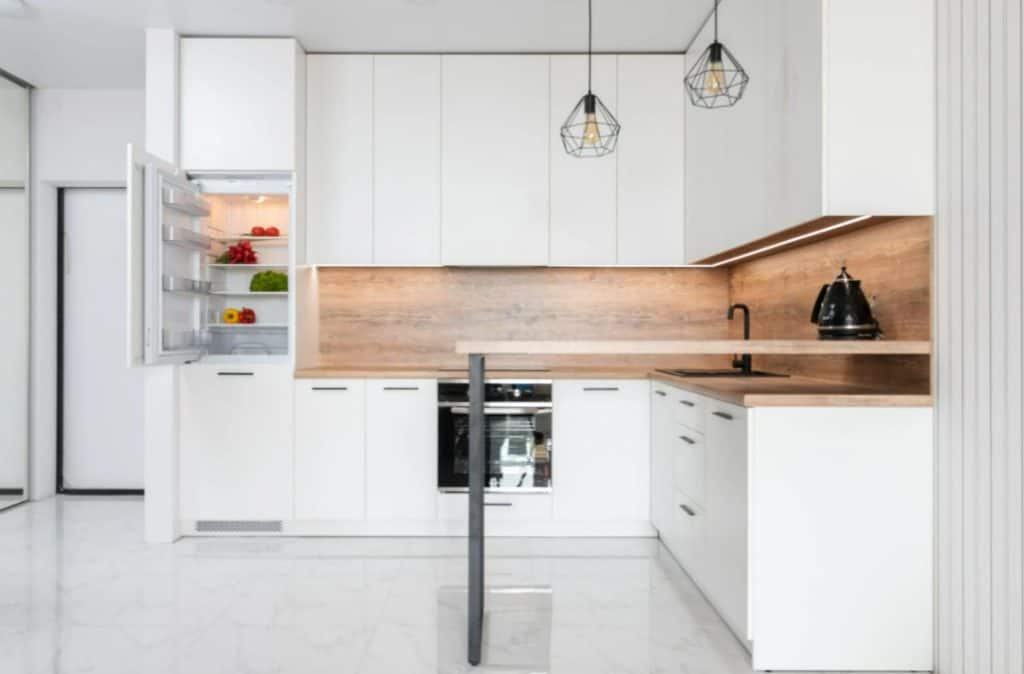
The size of your upper cabinets and the normal height of your ceilings are important. This will determine if your kitchen cabinets should go all the way up to the ceiling. Crown molding used to be used to hide the gap between the top of the kitchen cabinets and the ceiling in traditional cabinets.
Ceiling heights have changed in recent years, resulting in more space between the kitchen cabinets and the ceiling. People have the option of determining how high they want their cabinets to go. The outstanding dilemma is whether the area between the cabinets and the ceiling should remain open or be filled with extra cabinetry. This subject will be covered in this article, as well as the benefits and drawbacks of these kitchen cabinets.
KITCHEN CABINETS THAT GO TO THE CEILING HAVE BENEFITS
Additional Storage
It’s important to note that most people prefer 42″ tall upper cabinets because they give them a lot more space while also touching the ceiling. They also have the benefit of making the room feel bigger. This area is crucial because it may be used for storage much more easily than the restricted space available in cabinets that do not go to the ceiling.
Space That Is Both Decorative And Functional
A common feeling by people is that kitchen cabinets that extend all the way to the ceiling are attractive. In contrast to working with the open space directly above the cabinets, you can choose to put some lighting in the front cabinets for a more modern effect.
It’s reasonable to assume that some people would prefer to have some extra cabinetry merely to ensure that they reach all the way to the ceiling. Some people, on the other hand, like to leave the space right above the upper cabinets open. These individuals can choose to have some plants installed on that location, thus it is entirely a matter of personal preference.
Reduced Maintenance
Many people may choose to go against the norm and avoid placing plants in the region above the ceiling because they believe it will make the kitchen appear cluttered, old, and antiquated. This would also indicate that if you have more objects on top of the cabinets, you will have to clean and dust more frequently. As a result, ceiling-height cabinets are ideal since they lack a surface on which dirt or dust might easily collect. Cleaning and maintenance are simplified as a result of this.
A Well-Polished And Finished Appearance
These ceiling cabinets have a really nice and consistent appearance. As a result, people say they have a highly luxurious and attractive appearance.
KITCHEN CABINETS THAT GO TO THE CEILING DRAWBACKS
Accessibility
Because they are so high up in the ceiling, ceiling height cabinets are difficult to access. Anything at the top of these cabinets is difficult to reach, so you’ll need something to step on to get to it. This raises some severe safety issues as well. They are also highly expensive, so some individuals may feel priced out because they are beyond of their financial range. Fillers are required for these cabinets in order to make the uppers appear comparatively even. This helps to fix any areas of the ceiling that don’t appear to be flush.
Limit Your Design Choices
They do, however, limit you if you wish to use crown building for decorative purposes. If you insist on having crown molding for decoration, you’ll have no choice but to lower the kitchen cabinets to make this notion work, and most people aren’t willing to make this compromise.
Furthermore, crown molding is only used for aesthetic purposes and takes up a lot of room, so you shouldn’t use it to replace your kitchen cabinets. Finally, if you have a small kitchen, these cabinets might make it feel claustrophobic, congested, and cramped.
Summary: Should Kitchen Cabinets Go To The Ceiling?
The size of your upper cabinets and the normal height of your ceiling, which has steadily grown from 8 feet tall to 9 or 10 feet tall on the first floor, will determine if your kitchen cabinets should go all the way up to the ceiling. On the second story, the usual ceiling height has also been altered to 8 or 9 feet. Crown molding used to be used to hide the gap between the top of the kitchen cabinets and the ceiling in traditional cabinets.
Ceiling heights have altered in recent years, resulting in more space between the kitchen cabinets and the ceiling. People have the option of determining how high they want their cabinets to go. The outstanding dilemma is whether the area between the cabinets and the ceiling should remain open or be filled with extra cabinetry. This subject will be covered in this article, as well as the benefits and drawbacks of these kitchen cabinets.
Given the foregoing, it is evident that there is no conclusive solution to the question of whether kitchen cabinets should extend to the ceiling. It all relies on your preferences and what you consider to be perfect and appropriate. This is because kitchen cabinets that extend to the ceiling have some advantages and disadvantages, so it’s a fine balance to see which of the two outweighs the other.
If you have any questions about Should Kitchen Cabinets Go To The Ceiling? contact me today.
